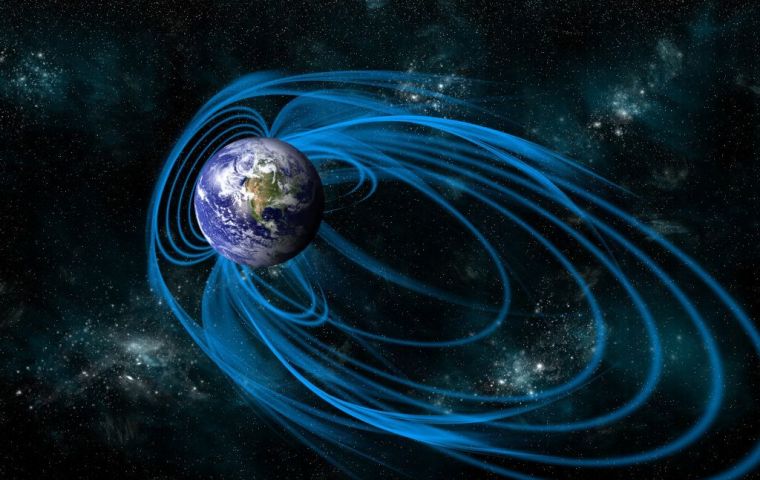MercoPress. South Atlantic News Agency
South Atlantic Anomaly and Evolving Dent in Earth’s Magnetic Field
 A fairly well-known phenomenon called South Atlantic Anomaly refers to the unusually weak magnetic field over S. America and the southern Atlantic Ocean
A fairly well-known phenomenon called South Atlantic Anomaly refers to the unusually weak magnetic field over S. America and the southern Atlantic Ocean A dent in the protective shield sounds scary for any person, but what are the scientists talking about when they say South Atlantic Anomaly? The researchers from the US space agency, National Aeronautics and Space Administration (NASA), recently noticed a growing dent in the Earth’s magnetic field over South America. And the news has caught on like wildfire across the digital community.
The dent refers to the weak magnetic field over a particular region of the Earth. But worry not, this change is not expected to have any direct impact on humans. A fairly well-known phenomenon called South Atlantic Anomaly (SAA) refers to the unusually weak magnetic field over South America and the southern Atlantic Ocean. And scientists acknowledge that this anomaly can pose a risk to spacecraft and satellites.
Moreover, the recent data from NASA shows that the dent is splitting into two, thus evolving into a major threat for future satellite missions.
What is Earth’s magnetic field?
The planet Earth has a strong magnetic field, and this magnetic property comes from its core, which hosts molten iron and nickel. You can easily know about its presence with the help of a magnetic compass, which always points north. Earth is similar to a magnet bar and the north and south poles represent the two sides. The invisible magnetic field lines encircle the planet between the North and the South.
This magnetic field can extend up to millions of kilometers in outer space. The core is in a constant state of motion about 1,800 miles below the surface and this motion helps to generate magnetic fields via convection currents that carry a stream of charged particles. Remember the popular homopolar motor experiment from the school?
The magnetic field is important as it prevents the Sun’s harmful charged particles entering the Earth’s atmosphere. Without the protective bubble of the magnetic field, the solar winds can easily damage the entire Earth’s atmosphere and biosphere. Moreover, this also protects the satellites orbiting the Earth from the harmful radiation. The absence of a strong atmosphere over Mars is also attributed to the lack of a magnetic field to shield its environment.
South Atlantic anomaly
As per NASA, the South Atlantic Anomaly arises from two main features—the tilt of the Earth and the flow of molten metals within its outer core.
The Sun expels a constant outflow of particles and magnetic fields known as the solar wind. The magnetic fields are aligned with a pair of doughnut-shaped belts known as the Van Allen radiation belts. These cloud-shaped belts specifically trap the charged particles streaming continuously through the solar wind and help to bounce off the particles from Earth’s magnetic field. The belts are part of the magnetosphere—the region of space where Earth’s magnetic field meets solar winds.
As per NASA, when the strong storm of particles from the Sun reaches Earth, the Van Allen belts can become highly energized and the magnetic field can be deformed, allowing the charged particles to penetrate the atmosphere. This is what is happening over South America and the southern Atlantic Ocean.
Currently, the SAA has no visible impacts on daily life on Earth’s surface. However, keeping a close eye on the anomaly is crucial for the proper functioning of our satellites and digital communications.
NASA says, “The recent observations and forecasts show that the (magnetic) region is expanding westward and continuing to weaken in intensity. It is also splitting–recent data shows the anomaly’s valley or region of minimum field strength, has split into two lobes, creating additional challenges for satellite missions.”
NASA has been monitoring these changes over South America and the Southern Atlantic Ocean. Continued weakening can significantly knock out onboard computers; in addition, interfere with the data collection of satellites that pass through it. Moreover, if a satellite in the low Earth orbit gets hit by the high-energy particles, then it can even lead to a short circuit and cause an event called a single-event upset or SEU.
Even the International Space Station also passes through the SAA and is dependent on the magnetic field for protection against the harmful radiation.




Top Comments
Disclaimer & comment rules-

-

Read all commentsApproximately every 180,000 years the magnetic poles shift, and this may be part of the indication the next one is finally starting, late. The good news is humanity has been here during the last 10 occurences of the GreatPoleShift, and our ancestors clearly survived them, as did most living things, so we too will survive it.
Aug 22nd, 2020 - 06:24 pm 0What, but we will all be upside down.
Aug 23rd, 2020 - 03:56 pm 0Commenting for this story is now closed.
If you have a Facebook account, become a fan and comment on our Facebook Page!